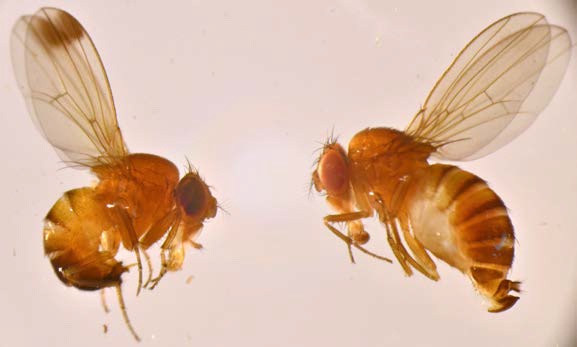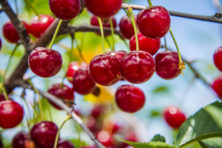Cherry Growers Have New Pest to Fight
- Share
- Tweet
- Pin
- Share

There’s a relatively new varmint in Door County that is causing concern for fruit growers.
Matt Stasiak of the University of Wisconsin Peninsular Agricultural Research Station gave an update on the dreaded spotted wing drosophilia (SWD) fly at an annual meeting of peninsula cherry growers held at Mr. G’s in Jacksonport on June 28.
SWD is a tiny and particularly nefarious type of vinegar fly, also known as fruit fly. There are many varieties of vinegar flies, but SWD is the only one known to damage healthy fruit crops.
While other vinegar fruit flies attack only damaged fruit, SWD females cut slits into healthy fruit in order to lay their eggs. The hatched larvae then consume the fruit from the inside before emerging to generate more SWD. Stasiak said there can be as many as a dozen generations of SWD in a single growing season. They are particularly attracted to berries, cherries, grapes and other fruit.
“It’s a very distinct hole in the cherry,” Stasiak said. “As the worm starts to feed in that cherry, the fruit gets softer. It gets hollowed out and the skin of the fruit pulls away from where that egg is laid. It can look like hail damage. It can look like rotten cherry. But if there’s a hole in there, it’s probably larva.”
SWD was first discovered infesting California fruit crops in 2008 and quickly spread across the country. Because they are so tiny – a couple millimeters – they can’t fly very far, so researchers believe its rapid spread was caused by human movement.
“You might not notice these things if they’re right in front of your nose,” Stasiak said in regard to their small stature.
Michigan fruit growers first saw SWD in their crops in 2010.
Stasiak said the pests first appeared in traps the research station sets in orchards throughout the county in 2013, and each year they’ve arrived earlier in those traps.
“Last year, as you all know, we started so see higher numbers during harvest period,” he said. “As we got into the harvest period, the numbers started to go up. This year we’ve caught them almost a month earlier than we have the last three years. Right now the numbers aren’t excessively high, but we have seen a slight uptake in the last week or so.”
Stasiak suggested the county’s fruit growers stay tuned in to the ag station’s website (peninsular.ars.wisc.edu) for SDW updates and information.
Preceding Stasiak’s presentation, Jim Seaquist, who last year was elected to a three-year term on the Wisconsin Cherry Board, said researchers in Michigan and Wisconsin are looking for permanent solutions to deal with SDW.

Seaquist also reported on the June 23 Cherry Industry Administrative Board meeting he attended in Grand Rapids, Mich.
“It’s a real early crop this year,” he said. “Oregon’s been going for a week and half. Washington’s been going for a week. Michigan is going to start Thursday or Friday.”
He said the industry has rebounded from the crop failure of 2012, but challenges remain, including more imported products coming from Poland and Turkey, “most of it in the form of concentrate,” he said.
“They’ve been able to increase imports in this country, but we have been able to keep our markets or grow them slightly,” he said.
Seaquist attributed some of the success of the American tart cherry market to a promotion program that began in 2005. He said the way to combat increased overseas cherry imports is to use the promotion program to differentiate between the dark red morello cherries grown in Poland and Turkey from the Montmorency tart cherries grown here.
“Montmorency is what they really need to buy. That is the big push,” he said.


